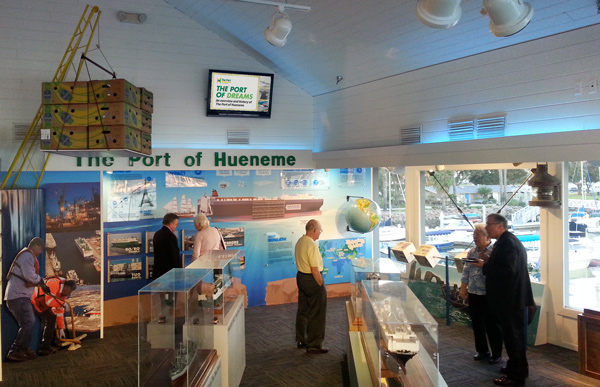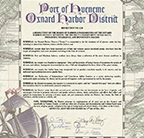The Channel Islands Maritime Museum Showcases The Port’s History and Operations
The Channel Islands Maritime Museum and the Port of Hueneme held an opening reception yesterday for the Museum’s new Port of Hueneme exhibit, more than a year in the making. Port representatives, City officials, Museum volunteers and exhibit professionals gathered on the Museum’s upper deck to celebrate the completion of this major project, made possible by generous support from the Port of Hueneme and Brusco Tug and Barge.
Port Commission President Jess Herrera said, “The exhibit increases public awareness of the Port and its importance in the economic development and the financial well-being of Ventura County”. The presentation is designed to engage the visitor and spark curiosity regarding the history of the Port, its customers, Port operations, the major imports and exports, the industries served, and the jobs it creates.
Few people realize that $8 billion in goods pass through the Port each year, bringing $1.1 billion in economic activity and more than 10,000 trade-related jobs to the region. The Port ranks among the top ten in the US for autos and fresh produce. Nearly every day, an army of longshore workers goes aboard a car-carrying ship to unload thousands of BMWs, Jaguars, Volvos, Hyundai and Kia automobiles just to name a few of the more than one dozen makes that routinely come through the Port.
The Port is one of California’s more active seaports. Since the port’s designation as a U.S. Port of Entry and the establishment of Foreign Trade Zone # 205 cargo throughput has risen to record levels. International businesses utilizing the Port of Hueneme originate from Costa Rica, Ecuador, Guatemala, Russia, Turkey Austria, South Africa, Brazil, Germany, Sweden Great Britain, Norway Poland Japan China, Korea, Guam, Mexico and Canada.
The Port’s success is due in part to its geographical position less than 60 miles from the greater Los Angeles area market. Its unique position near the Santa Barbara Channel also makes Hueneme the primary support facility for the central coast’s offshore oil industry. Up to 40% of California’s squid catch is handled through the Port of Hueneme.
The history of the Port can be traced back to the Chumash Indians who used Point Hueneme as a jumping-off point for canoe trips to the Channel Islands. Following settlement of the region by Europeans, a lighthouse was built, followed by a wharf to facilitate the export of agricultural products and the import of construction materials. Construction of a port began in the late 30’s, financed by local business people. No sooner than it was built, WW II broke out and the Navy took control. Today the Port is shared by the Navy and the Oxnard Harbor District.
Port CEO and Director Ms. Kristin Decas commented, “We appreciate our partnership with the Maritime Museum. This collaboration allows us to showcase the value that port operations bring to our community by way of jobs and economic development but just as important is the education element for our youth. Exhibits such as this help create understanding and appreciation of Ventura county’s maritime roots.”
The Maritime Museum is open daily 11-5 pm. Located at Oxnard’s Channel Islands Harbor, 3900 South Harbor Boulevard, on Bluefin Circle, the Port exhibit joins other permanent exhibits including a seascape gallery of rare and beautiful maritime paintings dating back to the 1600’s more than sixty world-class models of historic ships, and interactive contemporary exhibits.
The Port of Hueneme is one of the most productive and efficient commercial trade gateways for niche cargo on the West Coast. The Port is governed by 5 locally elected Port Commissioners. The Port moves $8 billion in goods each year and consistently ranks among the top ten U.S. ports for automobiles and fresh produce. Port operations support the community by bringing $1.1 billion in economic activity and creating 10,226 trade-related jobs. Trade through the Port of Hueneme generates more than $69 million in annual state and local taxes which funds vital community services




